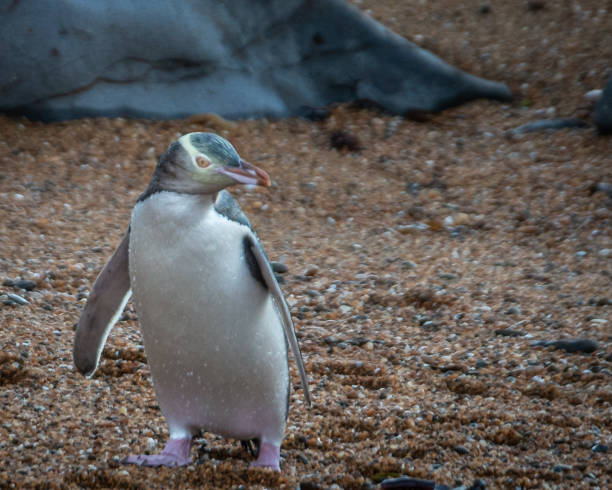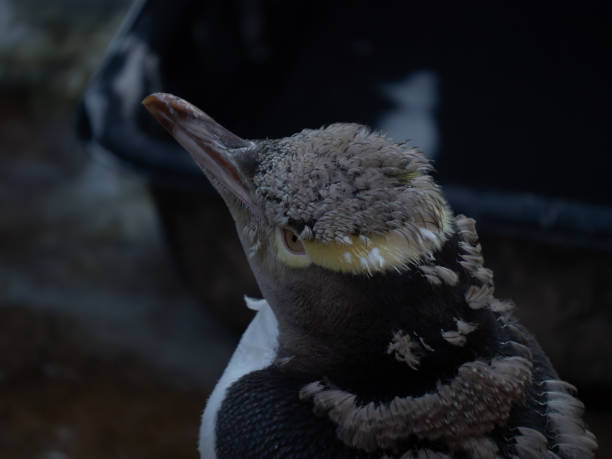Table of Contents
Scientific Classification
| Kingdom | Animalia |
| Phylum | Chordata |
| Class | Aves |
| Order | Sphenisciformes |
| Family | Spheniscidae |
| Genus | Megadyptes |
| Species | Megadyptes antipodes |
| Scientific Name | Megadyptes antipodes |
Description
The Yellow-Eyed Penguin, known as “Hoiho,” is one of the rarest and most distinctive penguins in the world. It features pale yellow eyes and a striking yellow band of feathers that extends from its eyes around the back of its head. Unlike many other penguins, the Yellow-Eyed Penguin prefers solitude and seeks out quiet nesting locations. Adults can reach heights of up to 65 cm (25 inches) and weigh between 5-8 kg (11-18 lbs). Their smooth, waterproof feathers and powerful flippers enable them to swim effectively, allowing them to dive deep in search of food.
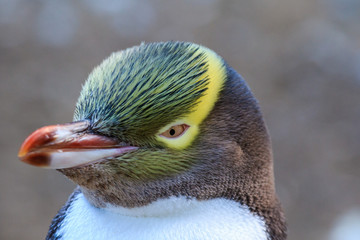
Distribution
The Yellow-Eyed Penguin is originally from New Zealand. You can primarily spot it along the southeastern coast of the South Island. It also inhabits Stewart Island, the Auckland Islands, and Campbell Island. This species is unique among penguins as it prefers warm, forested coastal regions rather than icy environments.
Habitat
Yellow-Eyed Penguins, in contrast to their Antarctic relatives, favor temperate forests, scrublands, and coastal regions. They require abundant vegetation for nesting. These penguins seek out quiet, secluded areas, often opting for steep slopes or dense bushes to protect themselves from predators and human activity. Such habitats provide essential shelter and safety. Unfortunately, deforestation and habitat destruction have increasingly hindered this species’ ability to find suitable nesting sites.
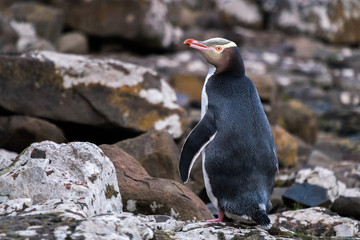
Diet
Yellow-Eyed Penguins primarily eat meat, with a diet that includes small fish such as sprat, blue cod, and red cod. They also enjoy squid and various other small marine animals. These penguins are excellent divers, capable of reaching depths of up to 100 meters (328 feet) and swimming considerable distances from shore in search of food. They rely on their keen eyesight and swift swimming abilities to catch their prey, returning to land after spending hours foraging at sea.
Behavior
Yellow-Eyed Penguins stand out from other penguin species. Unlike their more social counterparts, these penguins are generally more reserved and prefer solitude. They often forage by themselves and choose to nest in secluded areas instead of in large colonies. Their communication includes a range of calls, such as those used for territory and mating.
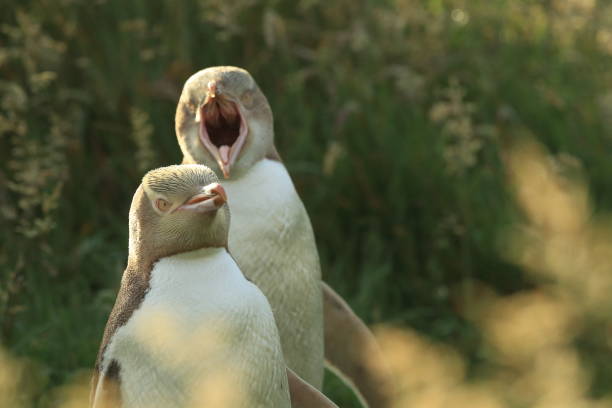
Lifespan
Yellow-Eyed Penguins typically have a lifespan of 10 to 15 years in the wild, although some individuals can live beyond 20 years. Unfortunately, many do not reach their full potential lifespan due to factors like predation, disease, and habitat loss. Additionally, human-related threats, such as getting caught in fishing nets and the impacts of climate change, have further decreased their chances of survival.
Reproduction and Lifecycle
The breeding season for Yellow-Eyed Penguins begins in August when they return to their nesting sites. These penguins are unique compared to others, as they prefer to nest alone in secluded areas among the vegetation.
Typically, pairs will lay two eggs, and both parents share the responsibility of incubating them for approximately 39 to 51 days. Once the eggs hatch, both parents feed the chicks with regurgitated food. The chicks remain with their parents until they fledge at around 100 days old. During this period, they face threats from predators and other dangers, making the care provided by their parents essential for their survival.
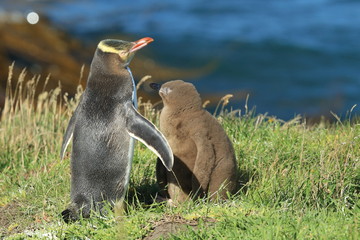
Predators
Yellow-Eyed Penguins encounter several natural and introduced predators. In the ocean, they face threats from sharks, sea lions, and fur seals. On land, introduced species such as feral cats, stoats, and dogs pose significant risks to their eggs and chicks. Additionally, human activities like tourism and habitat destruction have heightened their vulnerability.
Adaptations
Yellow-Eyed Penguins have developed several unique adaptations to thrive in their challenging coastal environment:
Excellent Diving Abilities: Their streamlined bodies and powerful flippers enable them to dive deep in search of food.
Sharp Eyesight: Their keen vision allows them to hunt effectively underwater, detecting movement even in dim lighting.
Water-Resistant Feathers: A dense layer of waterproof feathers keeps these birds warm and aids in buoyancy while swimming.
Solitary Nesting Behavior: They tend to nest alone, which helps them minimize competition and evade predators, setting them apart from other penguin species.
Conservation Status
The Yellow-Eyed Penguin is classified as Endangered on the IUCN Red List, with fewer than 4,000 individuals remaining in the wild. Their survival is threatened by habitat destruction, the introduction of new predators, human activities, and climate change. Conservation initiatives focus on restoring habitats, controlling predators, and monitoring breeding sites. Establishing protected areas and reserves plays a crucial role in supporting their population. Nevertheless, continuous conservation efforts are essential for their survival.
The Yellow-Eyed Penguin is a unique and endangered seabird that encounters numerous challenges due to environmental changes and human impact. Our dedicated conservation efforts are crucial in safeguarding this remarkable species and its fragile coastal environment for the generations to come.
